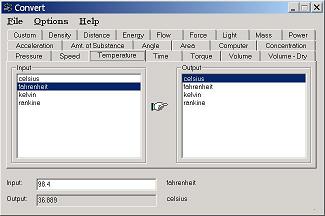

|
In-house training: Vilnis Vesma takes questions at an in-house training course on monitoring and targeting for Knauf Insulations, held in Dusseldorf in September 2012. Other organisations that have used this service include Building Automation Solutions, Caparo, Cylon Controls, Douglas Borough Council, Efficiency Direct, EnerNOC (California), Matrix SEE, Northern Design, Pacific Control Systems (Dubai and New Jersey) and Wessex Water. |

|
Certified Energy Manager: this flagship qualification, already held by over ten thousand professionals around the world, is coming to the UK with the first seminars and examination being held in two blocks in November and December. Read more... |

|
Certified Energy Manager: this flagship qualification, already held by over ten thousand professionals around the world, is coming to the UK with the first seminars and examination being held in two blocks in November and December. Read more... |

|
Transports of delight: Dron Kyle of Oxford Bus Company (standing) tells members of the local Energy Efficiency Forum about the dramatic success of their driver training programme which saw fuel savings of 5% to 13% across their fleet, plus a reduced accident rate. In-cab telematic monitors (right) warn drivers if their braking, acceleration, speed, idling or engine revs go outside the parameters for good fuel economy... And there are prizes for good performers. OBC are getting their money back in savings every 9 months. Just the ticket (Enough whimsical wordplay, -Ed.) |

|
|
Coming to a country near you? Vilnis Vesma (seated, centre) with delegates at his energy monitoring and targeting workshop in Santiago, Chile hosted by Agencia Chilena de Eficiencia Energetica on 9 March 2012. In June this workshop (and another on ISO50001) were held as open events in Hong Kong, and then it's California in August and Germany in September (both in-company events). Watch this space... |

|

|
Once you have achieved savings from an energy-saving campaign, how do you make the results persistent? Reading a book like John P. Kotter's "Leading Change" you would conclude that it is as much about what you do before the campaign as afterwards. (read the full advert or the one about carrots... ) |

|
Briton lands top M&V post: 24 January 2012: the Efficiency Valuation Organisation, publishers and promoters of the International Performance Measurement and Verification Protocol (IPMVP) has appointed a Briton as its executive director. Graham Wooding (left) is pictured here on day 2 of his new appointment with John Cowan, EVO's chairman, visiting ESCO-Europe in London. IPMVP is the de facto worldwide standard for the objective evaluation of energy projects. More on EVO; and M&V training in UK |

|
Vilnis Vesma on a technical consultancy visit to the Chilean Energy Efficiency Agency (AChEE) in January 2012, advising on the implementation of ISO50001 and particularly on the integration of energy monitoring and targeting. Pictured left with staff of AChEE, their client Norske Skog and consultants PwC at the Bio Bio paper mill in Concepcion. Right: with electricity suppliers Endesa at their power station at Quintero. |

|

|
We have set up a new web site with resources and facilities for people setting up energy management systems. Club50001.com includes free resources, links to training and publications, and other resources including ideas on how to achieve credible compliance without the cost of external certification. |

|
There's another chance to participate in one of Vilnis Vesma's energy monitoring and targeting workshops on 24 May in Birmingham |

|
Left: working with engineers at Pacific Controls Inc. in Somerset, NJ to critique and improve energy dashboards used by their remote building management clients. Right: the team get to grips redesigning and optimising displays. This was the final day of a three-day in-house training and development assignment carried in November 2011. "The whole workshop has been incredibly useful" - Arjun Punukollu, Assistant Manager |

|
Vilnis Vesma (left) with Jigar Shah of the Institute for Industrial Productivity in Beijing on an IIP-funded mission to advise the Chinese National Institute for Standardisation on energy systems optimisation in energy-intensive industrial sectors. Vilnis delivered a conference paper on performance evaluation and participated in several days of workshops with professionals from CNIS and the oil refining and iron and steel industries. |

|
VESMA.COM is now a BSI affiliate. So if (for example) you were to buy a copy of BS ISO 50001 by clicking here rather than going direct to BSI or elsewhere, you will benefit this web site through the commission that we earn. |

|
Delegates at July's Energising the Workforce workshop in London engage in group exercises, designing their own motivation and awareness programmes from first principles, based on what they have learned about industrial psychology and persuasion.
Check for similar workshops in future
|

|
 |
Metered natural gas supplies ideally need to be corrected for changes in calorific value (CV) as well as temperature and pressure (illustrated). Click here for information about where to get daily CVs (UK only). |
 |
Twenty-year average degree days are used for forecasting purposes. Now for the first time they are available for heating and cooling, and to assorted base temperatures, for the 18 standard UK reporting regions. Download them free as an Excel worksheet |
  |
I enjoy a good read... And here are some of the books that have inspired and informed my career in energy management. |
 |
Too right... Some time ago the Economist ran a special feature on data overload, a subject which many energy managers will know only too much about, especially those who have invested in automatic meter reading. One quote from Herbert Simon stands out: "What information consumes is rather obvious: it consumes the attention of its recipients. Hence a wealth of information creates a poverty of attention". If you are drowning in data and would like to know how to see in an instant which bits of it need your attention, why not sign up to my training course on monitoring and targeting? |

|
Each of these five column gauges can display a value (black rectangle) against a background showing threshold limits - in other words, as much information as a rotary-dial display occupying the same space as all five. Their compact design lets you create much-less-cluttered dashboard displays. Readers who have signed up to receive updates from me have been sent a link to an Excel workbook which does this kind of display... |
Sequencing fans with VSD
What's the best strategy for part-load operation of a bank of fans with variable-speed drives? Try this simulation. (V.V. 7 Jan 06)True or false?
If you are leaving the room for less than ten minutes, it's cheaper to leave the fluorescent lights on... find out, feeding in your own assumptions about the size and duration of the startup surge. (V.V. 6 Jan 06)Why poor power factor is a problem
If an electrical circuit suffers from poor "power factor", a higher current than necessary will need to be drawn in order to deliver the required power. This can increase power charges, or stress the supply infrastructure: see a simulation of the effect. (V.V. 6 Jan 06)
Sankey diagram softwareThe product recommended by one of our readers in October has been upgraded: click here for feedback from the user and news from the supplier.(V.V. 2 Dec 05) |
|
A carbon-neutral process, building, or vehicle operates on energy sources which are not derived from fossil fuels. Alternatively, if fossil-derived fuels are used, their carbon emissions can be offset by deliberate activities that permanently absorb an equivalent amount of carbon; the combination can be claimed to be carbon-neutral.This is rarely quite the whole story because the production of biofuels or uranium (for example) will entail using some fossil fuel. Interestingly, using electricity generated from landfill, mine offgas, and other 'fugitive' methane sources, is better than carbon-neutral because for each molecule of carbon dioxide the power station emits, it removes a molecule of methane which would have been over 20 times as damaging as a greenhouse gas. (V.V. 2 Dec 05)
Automatic controlsControls can have a part to play saving energy for all users from the largest to the smallest. As well as the well-rehearsed topic of controlling heating lighting and other building services, there are often opportunities in industrial situations as well: see article. (V.V. 20/11/05) |

|
Units conversionI noticed this rather neat units-conversion program on a someone's PC; download free from joshmadison.com (V.V. 14/10/05) |

|

|
What the...?I have been rummaging in the cellar and found some historical curiosities relating to degree-day measurement - V.V., 6/9/05 |